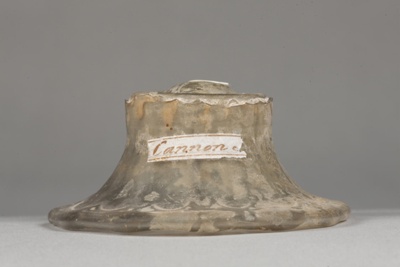< Collection search
< Collection highlights
From:UC Teece Museum of Classical Antiquities
Name/TitleGlassware
About this objectThis piece of Roman glass is believed to have been excavated in Cannon Street in the city of London. By the end of the 1st century CE Londinium, (London), was Roman Britain’s largest planned city with a population of 60,000 people.
Glass vessels were mass produced after the glassblowing technique was invented by the end of the 1st century BCE, and glass became an affordable commodity that people of all classes could use. The inherent attractiveness of glass, being nonporous, translucent (if not transparent), and odourless, along with the adaptability of shape and cheaper costs, encouraged people to change their tastes and habits, so that, for example, glass drinking cups rapidly supplanted pottery equivalents. In fact, the production of certain types of native Italian clay cups, bowls, and beakers declined through the Augustan period and by the mid-first century CE had ceased altogether. However, despite being produced in large numbers, ancient glass vessels seldom survive intact, because they are fragile and easily broken.
Made of almost clear glass, the surface of this piece has some slight flaking. The wall is flared and fluted. There is evidence that the piece may once have been attached to another piece of glass. We are unsure what the original purpose of this piece is. One suggestion is that it is a small dish, which could have been used for makeup preparation or holding powders, oils or waxes. Another suggestion is that the piece is part of the foot or stem of a larger plate or glass.
Date Madeca. 2nd Century CE
PeriodImperial (Roman)
Place NotesSaid to have been excavated from Cannon Street, London, England
Medium and MaterialsGlass
Style and IconographyRoman
Style and IconographyRomano-British
TechniqueGlassblowing
TechniqueMold-blown glass
MeasurementsHeight 36mm (preserved); Diameter 83mm
Named CollectionThe James Logie Memorial Collection, University of Canterbury, New Zealand
Credit LineDonated by the Nicholson Museum, University of Sydney, through Honorary Curator A.D. Trendall, 1953.
Object TypeUnidentified object
Object number31.53
Copyright LicenceAll rights reserved
